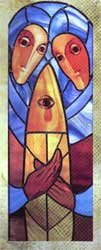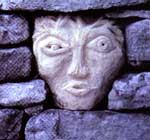|
DOM:
ARTS PROJECT
 |
DOM
is an arts project established in 1996 by a group
of international artists working in Scotland
. The project has permanent exhibition space at 8
Advocate's Close in Edinburgh's Old Town,
and also stages arts events in Scotland and elsewhere
in Europe. DOM, which means"home" in Russian,
aims to serve contemporary European culture, alert
to the need for artists, writers, musicians, composers
and filmmakers to assume greaterresponsibility for
the destiny of the arts as a whole.
|
|
 |
The
work of those affiliated to DOM cannot be defined in
terms of style or content, nor
in form or technique. Instead, they are bound by a quiet
guidance of something unspoken,
something which achieves expression through the artist.
This flow of creativity does not
have its source in the artist, it is not self-expression.
The artists affiliated to DOM tend to
work outside the mainstream, concerned to pursue the
solitary demands of their work.
DOM can offer opportunities for these often isolated
characters to gather together and
celebrate the wealth of kindred creativity. DOM stages
festivals, exhibitions and
performances across Europe as a way of introducing new
audiences to this powerful
undercurrent in European creativity today. These DOM
projects become opportunities
for the imagination, with artists and musicians paying
greater heed to the spirit in which
works are presented. DOM has also established a trading
arm, producing books, posters,
CDs etc, the proceeds of which go directly to fund exhibitions
and festivals. Here, Ewan
Allinson explores the spiritual and metaphysical ethos
that surrounds DOM. |
A
metaphysical wind stirs. Its tendrils animate the
ether at the edge of the autumn wood.Leaves and
twigs shudder with untold delight at this portent
of the gale's spirited embrace.There
is no reason to doubt that over the coming decades,
we shall be priviliged to
witness the creation of masterpieces which span
the chasm between the West'sparticular introversions
and that ever-onward dance of spirit and matter
whichbeckons our gaze. In composition, performance,
sculpture, painting, installation,poetry, philosophy
and filmmaking, a jolt of the unimaginable is already
at work.
The creative instinct to peer into the sources of
inspiration has not fared well this century.Intentions
have been there in abundance but expressions have
struggled. The attack oninherited forms at the outset
of the century, be it in music, painting or poetry,
was without
doubt intended partly to re-open the paths to profounder
sources of expression than thoseengaged for much
of the nineteenth century. The avant-garde identified
the very edge ofform to be the point at which something
pure could be incarnated into it. In music, Webern,
Scelsi and Xenakis without doubt demonstrated that
this was no vain conviction, as inpainting did Malevich,
Filonov and Klee. But the issue of form became the
issue andsuddenly a new orthodoxy was afoot. Other
developments introduced introversion,self-reference,
and an inflated need to be clever into the equation.
In European philosophy this century, an architecture
of original metaphysical thinkingwas painstakingly
devised by Heidegger but the burrowing work of Wittgenstein
on the one hand and Derrida on the other has left
the metaphysical enterprise asa whole looking decidedly
shakey. A cathedral of sentences can no longer house
the prayer of those who enquire into truth. The
deconstructive impulse withincontemporary philosophy
goes overboard though when asserting thatmetaphysics
is dead. Babies and bathwater come to mind. By all
means let'sstuff the meta-narratives and place them
in the archives, but let's also considerhow thought
might continue its adventure, relieved of baggage,
traversing landscapesknown to Kant, Hegel, Bergson
and others but freer to roam. To imagine that brilliant
minds will fail to prosper in such a setting is
ludicrous.
If imagination is to be the key to philosophical
endeavour in Europe then theuniversity regime might
not be the most fertile ground for it any longer.
|
|
|
|
In fact all these things, philosophy and the arts, would do
well to place themselveswhere they might best receive the
jolt of imagination which is their's for the taking. New contexts
for creative/metaphysical endeavour are in emergence throughout
Europe. And at the heart of these efforts, there is the recognition
that theeconomy
of the arts is something which merits utmost attention. Work
entails expenditure, expenditure entails revenue, and at present
revenue entailspatronage. The whole thing works on money and
the arts community has none.
The histories are already being traced of how the benefaction
of political operators (famously the F.B.I.) has influenced
the course of the contemporary arts in Europethis century.
Imagine then that the arts community finances itself and shapesloose
affiliations able to defend treasured values while able to
engage the political and business communities on an eye to
eye basis. Certainly not what John Lennonhad in mind, but
not impossible either.
For those grassroots arts projects springing up across Europe
- be theymetaphysical in inclination or otherwise - the conditions
for achieving a robustindependence are superb. Indeed as state
patronage and sponsorship diminishin scope, there is one obvious
and sustainable way forwards.
However, pursuing the labyrinthine issue of economy is not
the purpose of thisessay. What should be pointed out though
is that everything discussed so farreflects both the practice
and ongoing concerns of DOM, an arts project based,recently
settled into the medieval tenement in Edinburgh's Old Town.
The projectis entirely self-financed with a thriving design
company providing finance for thenon-profit work of the project.
In choosing to be a platform for work which is broadly metaphysical,
DOM concerns itself principally with the spirit in which work
is displayed,performed, and enjoyed. When you bring kindred
artists, musicians and the rest together, the scope for innovation
is untold.
The mores and conventions which rope the arts away from many
who wouldtreasure them, can be dispelled with a flourish of
imagination. For DOM andother
like groups, the purpose is to provide a setting for creative
spontaneity, inviting
in that jolt of imagination which hails from beyond the horizons
of ourblunted senses. In so doing, DOM is able to provide
a bridge between themetaphysical isolation of the western
soul and the wellsprings of the eternal
which beckon it. Nothing doctrinaire, no ideological baggage,
just a tangiblesense of freedom to engage those thoughts which
hail individuals regardlessof their background.
DOM does not aim to present a case for a particular metaphysics
through theworks there assembled. Rather, in assembling works
of a kindred mode, it aimsto give metaphysical reflection
some material with which to work. Though thereis no suggestion
of reaching conclusions, DOM does advance a metaphysical position
- a simple coracle of roughly hewn timbers able to carry individuals
into interesting waters. This position nods to the salty metaphysics
of the Atlantic fringe - Pelagius and Scotus Eriugena through
to Wordsworth,Thoreau, Dewey and Seamus Heaney. Not for DOM
the neo-platonic contempt for lichens and the everyday cycles
of growth and degradation. Nor the Cartesian reduction of
worlds to minds; self-expression is therapy,not art. Rather,
creativity in the arts is hailed as a wondrously distilled
echo of sources, expressions and yearnings which have found
on earth an abundance of opportunities from the Precambrian
onwards. The ancient Lewisian Gneiss has
been the bright setting and shows it in its folds of quartz
and feldspar. The artist merely refracts these sources through
her humanity in order that they may touch the souls of others.
DOM, in its north facing close off the Royal Mile, is but
a micro-climate in which a certain creativity prospers. The
conditions are favourable - Scotland's first gallery was established
on this spot as was the Encyclopaedia Britannica.We trust
in creativity as the cockerel trusts in the sun. We harbour
jolts of the
unimaginable. We welcome all.
Ewan Allinson is director of DOM, a sculptor & writer.
DOM is situated at 8 Advocate's Close, Edinburgh.
|
|